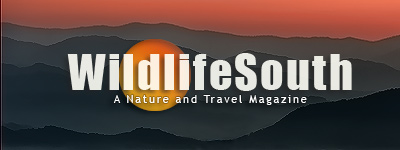Fort Motte Jail - South Carolina
(and a town that disappeared...)
Joe Kegley | E-Mail | Posted 01-01-2011
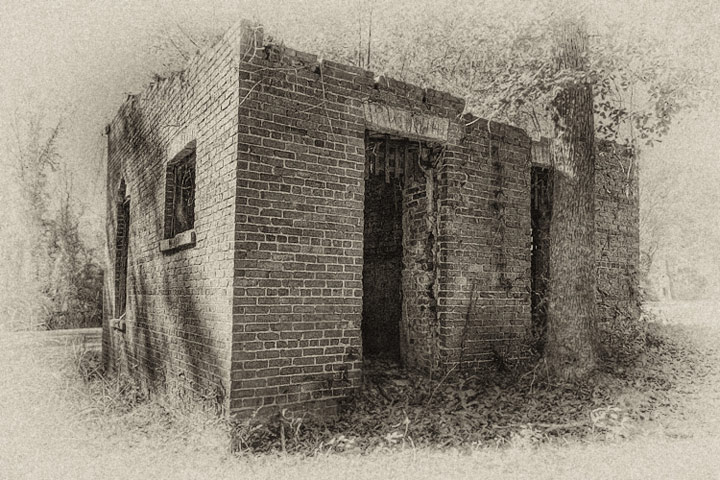
The Old Jail at Fort Motte (Note this is the rear of the building facing the two jail cell doorways) - Joe Kegley
There's not much left of the twentieth century town of Fort Motte. In fact, the ruins of an old jail and an abandoned post office are all that remain of a once thriving trade center for the local farming community. Town Square Street, which does in fact traverse a square (see bottom of page for map), implies the layout of the past commerce center. Both the jail and the post office front this route. Like many other small farming communities, the town evolved next to a railroad track. At one period Fort Motte was a shipping point for farming produce, cotton, and timber. No doubt the future advancement of major highway systems and trucking had a negative impact on the railroad industry, which in turn affected towns like Fort Motte.
The town is named after Rebecca Motte, whose nearby plantation was commandeered by the British and used as a fort during the Revolutionary War. Mrs. Motte was dismissed from her mansion and took residence at a nearby farm house. The "Siege of Fort Motte" took place when General Francis Marion and Lt. Colonel Harry Lee engaged the British in May 1781. Various interpretations abound, but a common thread of the story says Colonel Lee informed Rebecca Motte that the American forces needed to burn down her mansion to force surrender of the British. Being an enthusiastic patriot, Mrs. Motte not only supported the decision, but offered the bow and arrows used to set fire to the roof.
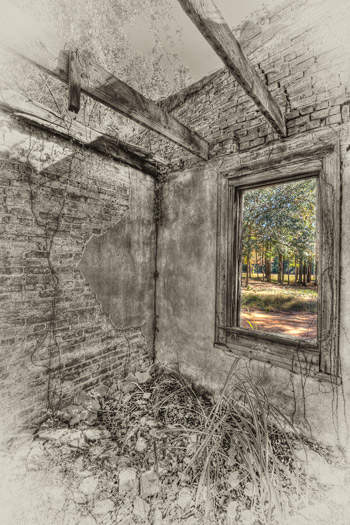
Inside the Fort Motte Jail Front Office Area- Joe Kegley
The Jail
The front of the jail has an engraved plaque listing the names of the first administrators and the date 1906. The plaque contains the following information in order of occurrence: "H.H. Cauthen - Intendent.", "B. Walling - Clerk and Treas.", "Wardens - J.G.Maynard, E. J. Bouzard, E.N. Brodie, J. E. Christie. 1906".
The structure is small, maybe 20' x 20' plus or minus 5'. The building contains three rooms, a front office area (which might have been divided but no partition remains) and two cells. The front door to the office faces southwest. The cells are entered from the outside in the rear of the building (northeast).
The roof over the office area is gone, though the structural beams remain. Building debris and vegetation cover the office floor area. With no roof, window glass, or doors, the office area is susceptible to the environment.
The two cells are fully covered except for one barred window in each cell and the doorways. The doors have been removed. Building material litters the floor in both cells though there is less vegetation inside than the front office.
The Post Office
The old Fort Motte Post Office is located on Town Square St, facing the railroad track. The front still shows its 29050 zip code marking. Various blinds cover the windows from the inside and particle board covers the doors and a few windows on the outside. The building appears to be divided into two equal segments with doors for each. I'm not sure if the post office resided in the first section of the structure with the zip code labeling or filled the whole building.
Photographic Study
The jail made for a pleasant photographic study. Because the structure is small, one can quickly encompass the whole building and obtain familiarity with various components in a short amount of time. The vegetation, weathered wood, worn masonry work, and rusted metal, offered highly detailed subjects to work with.
The original plan of attack was to obtain color HDR (high dynamic range) images using wide angle lenses, focusing on doorways and windows. For the most part I kept to that agenda. Not long after I arrived the wind picked up and much of the vegetation was moving. Moving vegetation can appeared blurred in landscape photography and can be a bigger problem with HDR photography where you are stacking the same composition at different exposures.
After processing the images, I decided the wind didn't influence the sharpness of the photos as much as I had anticipated, but the images just didn't look interesting to me. Granted, the Fort Motte Jail is not a beautiful scenic composition. The jail is a crumbling dilapidated building with weeds and vines growing all over it. But it is an "interesting" structure. How could I make my images reflect what I saw and how I felt when I was there, how could I make them look as interesting as I thought the actual structure was... convert them to black and white.
Unfortunately I have no experience with black and white photography, thus comes the inclusion of Nik Software, specifically Silver Efex Pro. Silver Efex Pro allowed a newbie like me to convert color images in Photoshop to interesting black and whites. No, this doesn't make me a B&W expert, far from it. And I have no intention of becoming an expert, I still prefer color. But in this case considering the history of the structures, black and white seemed appropriate and if software could help me do that then great.
Below are two examples of the side entrance to the jail office area. The first photograph frames the window within the doorway. One should note that the structure is not always plumb; some of the brick work has sagged or become displaced. Finding parallel lines within the building can be challenging at times. This image was converted to black and white using the preset "Antique Plate II" found in Silver Efex Pro. Minor adjustments were made with the Brightness, Contrast, and Structure sliders within the program. In addition, adjustments were also made to the "Vignette" sliders. The second image is a different perspective of the same doorway. This time I am including the front door on the right. Both images were taken with a Nikon 14-24 F/2.9G lens on a full frame digital SLR at 14mm. Having a lens with a very wide angle was a necessity for the doorway shots. The second shot was processed using the "Antique Plate I" preset. Similar adjustment sliders were used to finish the processing.
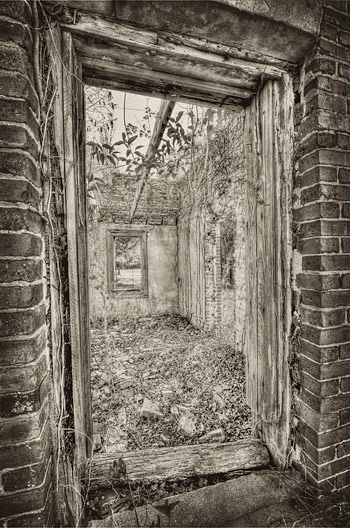
Different angle of side entrance into Fort Motte Jail Office - Joe Kegley
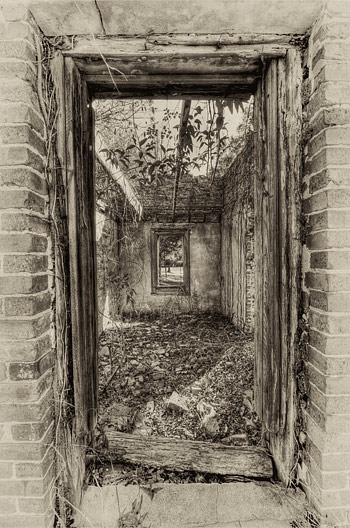
Side entrance into Fort Motte Jail Office
The two jail cells below were both processed using the "Antique I" preset then using the various adjustment sliders found in Silver Efex Pro mentioned above. The Nikon 14-25 F/2.8G was again used for both these shots.

Fort Motte Jail Cell #2 - Joe Kegley
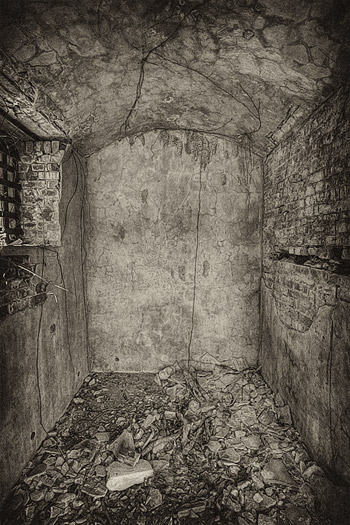
Fort Motte Jail Cell #1 - Joe Kegley
The images below are of the lone window for jail cell #2. I wanted a shot that included the surrounding brick work in addition to a more dramatic up-close capture of the window and bars. Note the second shot has additional bricks sitting on the window's outer sill. These were found directly below the window on the ground.
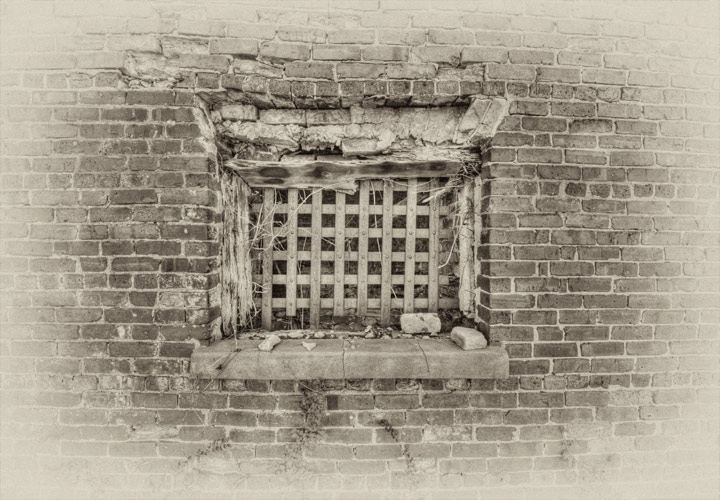
Fort Motte Jail Cell #2 Window - Joe Kegley
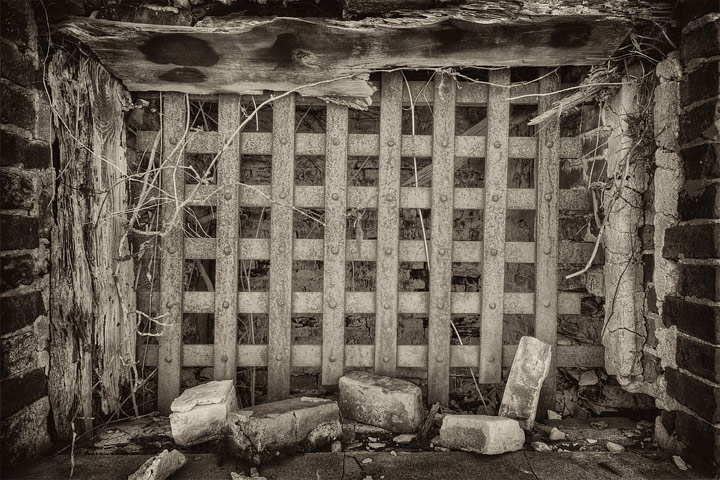
Closer take on Fort Motte Jail Cell #2 Window (with brick setup) - Joe Kegley
I can honestly say with conviction that the Fort Motte Post Office is not near as interesting a subject for photography as the old jail. The image below is included to make this article complete. There is a fallen structure in the woods to the right of the post office (not in the image). I'm not sure if that is an old homestead or another business establishment.
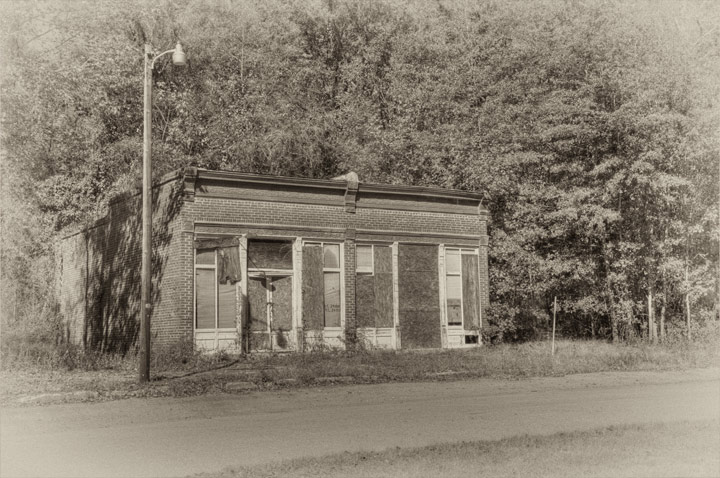
Fort Motte Post Office - Joe Kegley
Fort Motte Map
Note "Town Square St" which loops around the missing town.
